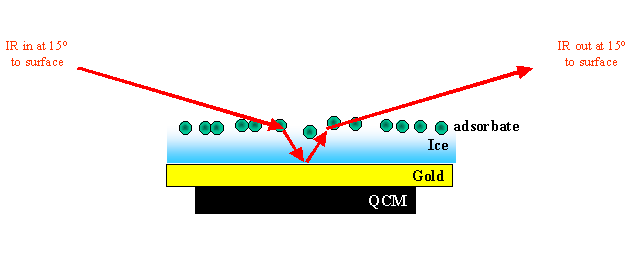Reflection-Absorption Infrared Spectroscopy
(RAIRS/IRAS)

This spectroscopic technique is used to probe the gas-solid interface.
Infrared radiation (IR) is directed onto the sample and reflected from
an underlying metal surface. The signal can be absorbed by both the bulk
ice molecules, surface ice molecules and the adsorbate molecules on the
ice surface. The gold surface is chemically inert, so it does not have
a direct effect on the behaviour of the ice, but it will produce characteristic
features in the IR spectrum. However a direct absorbtion spectrum is obtained
by ratioing the ice spectrum with a 'background' spectrum of the gold film
alone. This also eliminates spurious atmospheric signals from the spectrum.
 Infrared radiation is used to probe vibrational molecular motion. Only
those vibrations whose dipole moment lies perpendicular to the metal surface
can be observed. This is because the incident and reflected p-polarised
components of the radiation superimpose constructively (add together),
enhancing the signal, whereas the s-polarised components cancel each other
out, (as they undergo a phase change on reflection from the metal surface).
Infrared radiation is used to probe vibrational molecular motion. Only
those vibrations whose dipole moment lies perpendicular to the metal surface
can be observed. This is because the incident and reflected p-polarised
components of the radiation superimpose constructively (add together),
enhancing the signal, whereas the s-polarised components cancel each other
out, (as they undergo a phase change on reflection from the metal surface).
RAIR spectra show bulk and surface features. These are used to characterise
the structure of the ice and the ice surface and to evaluate the nature
of the bond between molecules in the as as well as the ice and the adsorbate.
Dangling OH bonds at Ice Surfaces
|
 |
In water ices one of the most distinguishing spectral features is the OH
stretching vibration. The bulk OH stretching vibration dominates an ice
spectrum. Just on the shoulder of this feature a second signal exists,
(see spectrum oposite) which is attributable to the OH bonds that are dangling
from the surface of the ice. In a thick ice sample this feature is quite
weak as there are far fewer OH bonds at the surface compared with the bulk.
It is also a more ditinctive feature than that of bulk OH, since the OH
itself is less tightly bound in the lattice.
In water ice the dangling OH stretch appears at
-
3692cm-1 in crystalline ice
-
3696cm-1 in 3-coordinate ice
-
3720cm-1 in 2-coordinate ice
The positions of these peaks shift according to the adsorbate on the ice. |
In this experiment the IR spectrum is recorded using a Fourier Transform
(FT) spectrometer, which encompasses a 60o Michelson Interferometer.
Interferometeric techniques greatly enhance the speed and sensitivity at
which this type of spectrocopy is conducted.
The IR data ties in with IR regions observed by the astronomical community.
They have already observed ice features in astronomical spectra taken in
lines-of-sight towards reddened stars where visible light has been obscured
by dust.
The FTIR spectrometer was purchased from  Biorad
Biorad

The Surface Astrophysics experiment is part of  Nottingham Astronomy Research Forum
Nottingham Astronomy Research Forum
and is based in the Surface
Science Group in the School
of Chemistry at the University
of Nottingham
These pages were last updated 14/10/01


![]() Biorad
Biorad